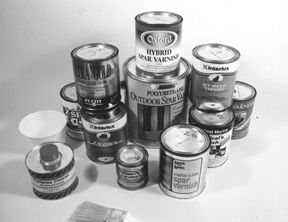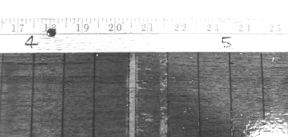In recent years we have forsaken the testing of traditional varnishes for what might generically be called “teak treatments”—mostly oils, urethanes like Honey Teak, and pigmented stains such as Cetol and Armada, and some hybrids such as Smith & Co. Five Year Clear™ epoxy and urethane treatment. These reports have appeared annually in the March issue’s special section on spring maintenance. The reasons for passing over varnish were mainly the strong perception that three coats of Cetol will last a full sailing season, whereas three coats of varnish might disappear by August 1.

I
Many of the longest lasting teak treatments contain pigments that tend to cover the wood grain and make the surface look muddy. But even mud looks better than yellowing, peeling varnish. For many owners, longevity counts more than appearance.
But not for everyone. And few would disagree that nothing equals a good varnish for bringing out the sheer beauty of wood—the finely detailed grain and the rich color tones of yellow, red and brown. Wouldn’t it be nice if varnish could be made to last as long as pigmented stains? To find out, we decided last year to begin testing varnishes again.
The Products and the Test
We bought 19 different cans of varnish and one can of pigmented stain—West Marine’s Wood Pro—as a point of comparison. Each was applied to a solid teak panel and set outside oriented toward the sun.
Manufacturer instructions for wood surface preparation vary somewhat, but all call for some sort of cleaning and sanding. Some recommend using TSP or alcohol, others want proprietary brushing liquids applied, such as Interlux #333. Some just say, “clean and sand.” Some makers specify the sandpaper grit, ranging from #80 to #400. The majority seems to favor #220, which is what we used on all panels.
When testing coatings of any type, there always looms the question of whether to apply the manufacturers’ recommended number of coats, or the same number of coats of each product regardless of recommendation. For example, if varnish A requires 3 coats and varnish B 5 coats, how many coats of each do you apply? If following manufacturer’s recommendation, is it fair to compare 3 coats to 5? Surely the 5 coats will last longer…unless varnish A’s 3 coats are thicker than B’s.
For this test, we decided to list in the table on page 16 the number of recommended coats, and then apply the same number of coats of each product—2, 3, 5 and 7. If a manufacturer recommended more than 7 coats, that was done. This was required only of Oxford Hybrid Spar Varnish, which requires 9 coats. Seven coats covered all other products (if the label called for 7-8 coats, we applied 7). In any case, we expected each varnish to fail in the thinnest 2-coat section before the 3-coat, 5-coat and 7-coat sections.
The top portion of each panel was covered with a wooden ruler to preserve the original “true” color of each section.
Some instructions call for thinning the first or more coats, sometimes with paint thinner, other times with proprietary cleaners. All thinners were purchased and used as directed. The vast majority of varnishes call for sanding between coats and this was done.
While stirring conventional varnishes is taboo, three of the test products do require stirring—US Paint’s AwlSpar, Oxford Hybrid Spar Varnish and Sears Polyurethane Outdoor Spar Varnish.
Out-of-the-ordinary products are the Oxford Hybrid Spar Varnish, which was the only water-based varnish tested, and Interlux Interthane Plus, which is a two-part product. The complete list is found in the table. (Last month, Nick Nicholson reported in Offshore Log that Interlux Clipper is now called Goldspar.)
Results
With the teak panels exposed to the weather, we checked for signs of degradation once a month. The rulers were removed and the color of the exposed panels compared to the original covered sections.
After two months, no discernible changes were observed. After three months, one could detect subtle differences between the covered and exposed sections, but only when viewed from a very oblique angle.

After three months, differences in color grew evident. The more heavily coated sections (5-7 coats) of #13 Pettit H-Build, #6 Z-Spar Captain’s and #17 Oxford Hybrid had become somewhat darker than the lightly coated sections (2-3 coats).
Those in which the exposed portions were darker than the portions covered by the ruler were: #11 Epifanes clear and #12 Epifanes Wood Finish.
Others began to show bleaching: #7 Z Spar Flagship, #18 Sears Outdoor Poly, and #19 Cabot Oil-based Poly.
Judged best were #16 AwlSpar and #20 Last n’ Last.
No significant changes were observed over the next two months and we began to think that this initial six-month report would contain only notes on color. But that was not to be.
At six months, a number of varnishes had failed in the 2-coat sections only, that is, bare wood showed in the middle of the section—Interlux Clipper Clear, West Marine Skipper, Epifanes Clear, Pettit Hi-Build, and the Sears Poly Outdoor.
Another group was clearly starting to fail, usually at a tape edge where water could get under the coating. Some varnishes seemed to seal better than others. These were: VC Plus-5, Interthane +, West Marine Admirals, Epifanes Wood Finish, Oxford Hybrid, Cabot Oil-based, and Last n’ Last.
The best were Interlux Jet Speed and Schooner, and Pettit Captains.
The remaining varnishes were judged as Good.
As noted above, some varnishes became lighter with exposure, others darker. But even before exposure, some naturally make the wood much darker than others. We rated them Light, Medium and Dark on the chart, but made no judgments, figuring this is a matter of personal preference. (But just in case anyone wants to know our opinion, we think the dark varnishes obscure the grain too much.)
Other notes of interest:
• The only water-based varnish in the group, Oxford Hybrid Spar, is holding its own against the others. Early water-based coatings of all types, including bottom paint, have not performed as well as traditionally formulated products, but perhaps Oxford’s performance heralds an improvement. Water-based coatings certainly are better for the environment, as they do not contain the same solvents, and they are easier to clean up after.
• Interlux Interthane + is a two-part varnish that appears to be tougher than the other films…time will tell.
• Interlux Jet Speed had a nasty tendency to skin over right from the first time we opened the can. By the time we finished applying all 7 coats the skin was so thick we had to use a paint stick to lift it out in big globs. And that’s a waste, not to mention annoying should a piece of skin get through your defenses (varnish should be poured from the can into a second container; and old-timers may still pour varnish through cheesecloth to strain contaminants). The label on the can says, “Fast Dry Varnish for Quick Overcoating.” No kidding! Ours dried right in the can.
Conclusion
At the six-month mark, we have a number of good-looking varnishes that seem to be holding up well. As expected, the 2-coat panels are failing first while the thicker coatings remain intact.
A final observation: Just because the 2-coat section of a particular varnish fails before some others, doesn’t necessarily mean its 5- or 7-coat sections also will fail before those other varnishes. Time will tell, and we’ll have to wait at least a few more months—and possibly longer—to learn which varnishes last longest when the recommended number of coats are applied.
Contacts- Absolute Coatings, 38 Portman Rd., New Rochelle, NY 10801; 914/636-0700. Cabot, 100 Hale St., Newburyport, MA 01950; 800/US-STAIN. Epifanes North America, 58 Fore St., Portland, ME 04101; 207/775-1333. Interlux Yacht Finishes, 2270 Morris Ave., Union, NJ 07083; 908/686-1300; 800/INTERLUX. Pettit Paint, 36 Pine St., Rockaway, NJ 07866; 800/221-4466. Sears, Roebuck and Co., Hoffman Estates, IL 60179; 800/9 PAINTS. Target Enterprises, PO Box 1582, Rutherford, NJ 07070; 800/752-9922. U.S. Paint, 831 S. 21st St., St. Louis, MO 63103; 314/621-0525. West Marine, PO Box 50070, Watsonville, CA 95077; 800/262-8464. Woolsey/Z-Spar (Kop-Coat Marine Group), 36 Pine St., Rockaway, NJ 07866; 800/221-4466.
Also With This Article
Click here to view Value Guide: Varnish.
































